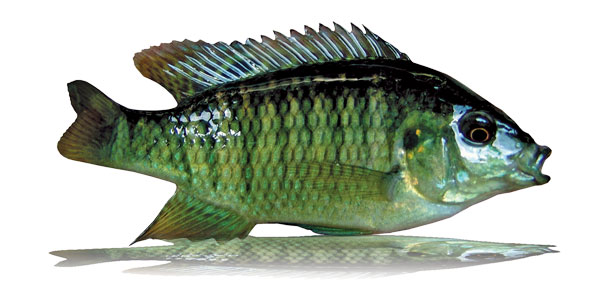
The Vlei Kurper or Banded Tilapia (referred to as a “Vlei” among artlure anglers) is a standard food source for bass all over southern Africa and is commonly stocked in bass dams as a fodder fish. This species is on the bass’ menu list in all the major dams in South Africa and Zimbabwe including Lake Chicamba in Mozambique. The Vlei Kurper, like the Red Breast Kurper, is part of the tilapia family that commonly occurs throughout Africa. Vlei Kurper does extremely well in dams with abundant vegetation. Only juvenile Vleis school and sexually mature fish pair off as male and female.
Vleis can be easily caught using earthworm, a small curly tail grub or even a small spinner. On ultra light tackle a big Vlei can give you a fantastic fight but they are too small to be of real angling interest and it is only the artlure fraternity that target them as an angling specie.
Most bass fishermen know how a Vlei looks and is probably the major reason why Watermelon and Pumpkinseed colours work so well throughout the country. Bass anglers however know very little about their behaviour and habits and this article is aimed at providing a deeper insight into the Vlei Kurper as bass prey fish specie.
Description
The colours of the Vlei Kurper can range from silver to olive-green, with the sexually mature fish invariably olive- green. They can have up to nine vertical stripes of a darker green or black. These stripes are a real trigger point for bass. During the summer breeding season, both sexes of Vleis become more colourful and the vertical stripes become dark to black. It is very difficult to distinguish between the male and the female and the only real difference is that the male Vlei develops a red edge on his dorsal fin and tail and blue-green spots appear on dorsal and anal fins during the breeding season. Vleis have a roundish body, small head, round tail and its dorsal fin is the most forgiving of all the tilapia species in terms of causing injuries to predators - you can find a dead bass with a Red Breast or Blue Kurper stuck in the throat but vary rarely a Vlei Kurper. When looking at them in the water you can recognise them by their elegant movements, dark greenish colour, distinctive bars or stripes along the sides and often blue lower lip.
Food source
Adults feed preferentially on filamentous algae, aquatic plants and vegetation on the water edge like leaves, plants and seeds. They will also not say no to small crustaceans, midge larvae, water insects and even small fish, but prefer plant material. If you find a Vlei in an area with no vegetation, it probably means there is no vegetation in the dam.
Size
There is no difference in size between the male and female, which can grow to 23.5 cm in ideal conditions. The South African record of 445 grams was caught in RoodeKoppies Dam on a small plastic grub. The average size of the sexually mature Vlei is around 12 cm (5 inches).
Habitat
Vlei Kurper occur in a widely diverse habitat. They favour areas where plant cover exists along the edges of rivers, dams, lakes or swamps. They prefer shallow sheltered waters and do not colonize the open water of large lakes. They love to enter newly flooded areas and feed on the vegetation and organisms now covered by the water. The picture illustrates typical Vlei habitat in sheltered bays.They relate to and live on the bottom around the vegetation. They are comfortable in freshwater and brackish water. They prefer standing or slow-flowing water and thrive in impounded waters (dams). They will relate to any kind of structure that has got plant or filamentous algae growths and this includes areas with vegetation, trees, lay downs, man made structures and launch ramps, but predominantly in shallow water unless the water is very clear. The weed line shows you how deep they will go, normally not much deeper than 12 ft, but if you fish deeper and find any vegetation stuck to your lure you can use a Vlei imitation with confidence.
Breeding Habits
The breeding months are from November to March. Vleis are not 'mouth-brooders' like the cichlid family, but are dedicated parents that will aggressively protect their nest, their eggs and their young. The male selects a spawning site and hollows out a nest at the base of a rock or an underwater plant. The male Vlei will then entice a female to lay her eggs, after which he will fertilises them. Both parents stand guard over the eggs, and fan water over them with their fins. Both the Vlei parents continue to keep a close watch on their young after they hatch and swim around in a silvery shoal while feeding on microscopic organisms. When there is danger the young will take refuge in the mouths of the parents. I have always been amazed at the behaviour of the Vlei parent during this period. They aggressively protect the young while they have them in their mouths. A Vlei will for instance hit a spinner with a mouth full of young and still try and keep his/her mouth closed even after you have taken him/her out of the water. It is the breeding parents we want to imitate to improve our bass fishing success. They are aggressive and defend their territory. They are however well camouflaged in their little underwater forests. If you can get a Vlei imitation to suddenly appear in front of a bass cruising the weed line you can be sure of an aggressive strike.
Recent Research Findings
While most of our baitfish species relate to the edges of vegetation in the open water, the Vlei Kurper is very comfortable inside the thickest of the underwater vegetation you can find. When you catch a Vlei on light tackle, it tries to escape in the shallow water vegetation and does not rush off to deep water. I have spent hours watching small groups of bass hunt Vleis in a clear water quarry. On one particular afternoon, the Vlei were hiding or eating inside thick grass newly covered by the water after some good rain. The water was only one to two foot deep in the grass. A group of four bass had no chance of catching the Vleis in the grass and used team work to secure their meal. Three off the bass would wait just outside the edge of the grass while one rushed into the grass with speed. Any Vlei leaving the grass in an effort to escape the bass that rushed into the grass got smashed by the three bass waiting. The bass would take about 20 minutes to regroup and repeat this process. I was convinced that they alternated positions to all get a good meal. When bass cruise the edges of the weed line you can not go wrong with working a Vlei imitation along the edge or out into the open from the thick vegetation. It is recommended to weight your imitation and fish it close to the bottom. Pitching Vlei imitations into small openings in thick vegetation allows you to present a food source to big bass that probably attracted them to the area in the first place. Bass will hide motionless in the shade inside the vegetation waiting for an unsuspected Vlei to get close enough for a strike.
Conclusions
Next time you fish any vegetation try imitating one of the bass’s favourite food sources, the Vlei Kurper. Fish into the vegetation as that is where the bass will hide to ambush an unsuspected Vlei. Very few bass will reject a Vlei venturing so close to it. Make sure your imitation shows the dark bars along the sides that act as a trigger for the bass in this underwater forest.
Remember – a smaller bass is not very fussy, but if you want to trigger a big bite consistently, do everything you can to put the odds in your favour. Don’t only match the hatch with the bait you choose but also by the way you fish it and where you fish it.


 Visit us our
Visit us our